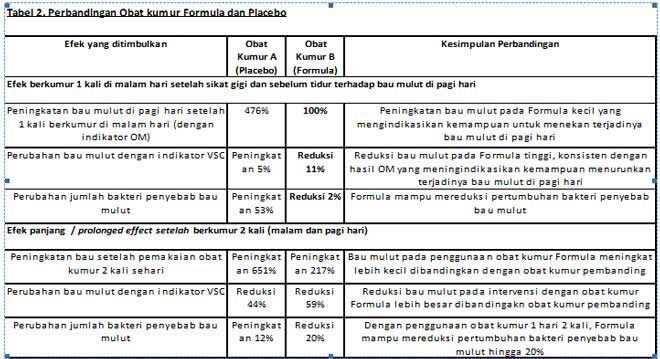Efficacy of Triclosan and Monomenthyl Succinate Containing Mouthwash Against Halitosis
Most cases of bad breath (halitosis) originate in the oral cavity. Other factors that caused halitosis are food/drinks, poor oral hygiene, periodontal disease, dry mouth (xerostomia), systemic disease, smoking and bacteria. Anaerobic gram negative bacteria (black pigmented bacteria) in deep crypts at the back of the tongue and in deep periodontal pockets process the protein and release Volatile Sulfur Compounds (VSCs) which perceived as halitosis. VSC consists of hydrogen sulfide (H2S), methyl mercaptan (CH3SH) and dimethyl mercaptan (CH3)2S.
Mouthwash has been used to reduce bad breath. Mouthwashes available in the market use various active ingredients which have different effect on halitosis.
Formula and Faculty of Dentistry, Universitas Indonesia conducted a study to evaluate the effectiveness of mouthwash containing triclosan and monomenthyl succinate (Physcool) in reducing bad breath in the morning and its prolonged effect (up to 12 hours after the second rinsing).
Method
The study was a cross-over, randomized, controlled clinical trial with 15 subjects in each treatment group and control group.
Parameters measured in this study were:
- Organoleptic measurement by calibrated examiners.
- VSCs and other gases that contributed to bad breath were performed by OralCroma.
- Total count of black pigmented bacteria (Porphyromonas gingivalis, Prevotella intermedia, and Fusobacterium nucleatum).
Each subjects were instructed to rinse their mouth with the mouthwash before sleep at night and the first measurements were taken in the morning at the following day. After brushing their teeth, the subjects were instructed to rinse their mouth and the measurement were performed directly after rinsing for black pigmented bacteria and after 4, 8 and 12 hours for OM and VSC.
Results
Table 1 showed the mean value of organoleptic measurement (OM), VSCs and total count of black pigmented bacteria. Organoleptic measurement value increased after several hours of intervention, but the increment percentage of treatment group is significantly lower than the control group.
The VSCs was significantly inhibited after rinsing with mouthwash containing triclosan and monomenthyl succinate. The results were parallel with the significantly reduced total count of black pigmented bacteria.
Table 1. Mean value of Organoleptic Measurement (OM), VSCs and total count of black pigmented bacteria

A = control
B = mouthwash with triclosan and monomenthyl succinate

Conclusion
Mouthwash containing triclosan and monomenthyl succinate effective in reducing bad breath measured both organoleptically and chemically (VSCs). The significantly reduced value of VSCs was correlated with the reduced total count of black pigmented bacteria.
Reference
Shinada K, Ueno M, Konishi C, Takehara S, Yokoyama S, Kawaguchi Y. (2008). A randomized double blind crossover placebo-controlled clinical trial to assess the effects of a mouthwash containing chlorine dioxide on oral malodor. Trials, 9 : 71.
Annemiek M.W.T. van den Broek, Louw Feenstra, Cees de Baat. (2007). A review of the current literature on aetiology and measurement methods of halitosis. Journal of Dentistry, 35:27-635.
Charles, C.H., Cronin, M.J., Conforti, N.J., Dembling WJ, Petrone DM, Mcguire JA. (2001). Anticalculus efficacy of an antiseptic mouthrinse containing zinc chloride. JADA, 132:94-98.
Teles, R.P. and Teles, F.R.F. (2009). Antimicrobial agents used in the control of periodontal biofilms: effective adjuncts to mechanical plaque control? Braz Oral Res, 3:39-48.
Amini, P. , Araujo, M.W.B., Wu, M., Charles, C.A., Sharma, N.C. (2009) Comparative antiplaque and antigingivitis efficacy of three antiseptic mouthrinses: a two week randomized clinical trial. Braz Oral Res, 23:319-25.
Saad, S., Greenman, J., Shaw, H. (2010). Comparative effects of various commercially available mouth-rinse formulations on oral malodour. Oral Diseases, 17:180.
Charles, C.H., Sharma, N.C, Galustians, H.J., Qaqish, J., Mc Guire, J.A., Vincent, J.W.. (2001). Comparative efficacy of an antiseptic mouthrinse and an antiplaque/antigingivitisdentifriceA six-month clinical trial. JADA, 132: 670-675.
Kocak, M.M., Ozcan, S., Kocak, S., Topuz, O., Erten, H. (2009). Comparison of the Efficacy of Three Different Mouthrinse Solutions in Decreasing the Level of StreptococcusMutansin Saliva. Eur J Dent, 3:57-61.
Kazor, C.E., Mitchell, P.M., Lee, A.M., Stokes, L.N., Loesche, W.J., Dewhirst, F.E., Paster, B.J. (2003). Diversity of Bacterial Populations on The Tongue Dorsa of Patients With Halitosis And Healthy Patients. Journal of Clinical Microbiology, 41:558–563.
Fine, D.H., Furgang, D., Markowitz, K., Sreenivasan, P.K., Klimpel, K., Vizio, W. (2006). The antimicrobial effect of a triclosan/copolymer dentifrice on oral microorganisms in vivo. JADA, 137(10):1406-13.


